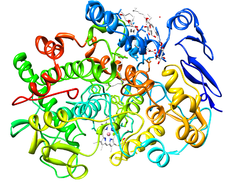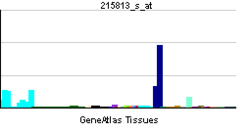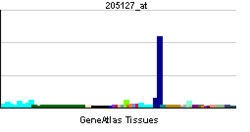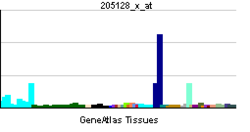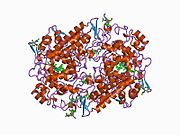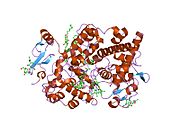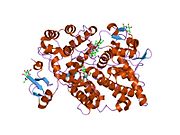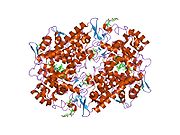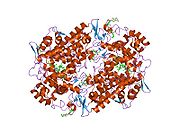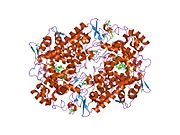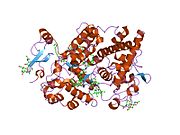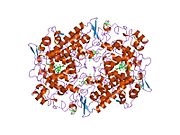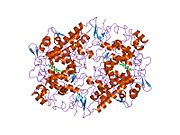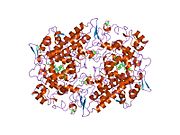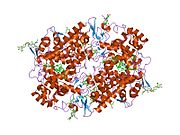- PTGS1
-
- "COX-1" redirects here. COX-1 may also refer to mitochondrial cytochrome c oxidase subunit 1 (cox1).
Cyclooxygenase-1 (COX-1), also known as prostaglandin G/H synthase 1, prostaglandin-endoperoxide synthase 1 or prostaglandin H2 synthase 1, is an enzyme that in humans is encoded by the PTGS1 gene.[1][2]
Contents
History
Cyclooxygenase (COX) is the central enzyme in the biosynthetic pathway to prostaglandins from arachidonic acid. This protein was purified more than 20 years ago and cloned in 1988.[3][4]
Gene and isozymes
There are two isozymes of COX encoded by distinct gene products: a constitutive COX-1 (this enzyme) and an inducible COX-2, which differ in their regulation of expression and tissue distribution. The expression of these two transcripts is differentially regulated by relevant cytokines and growth factors.[5] A splice variant of COX-1 termed COX-3 was identified in the CNS of dogs, but does not result in a functional protein in humans. Two smaller COX-1-derived proteins (the partial COX-1 proteins PCOX-1A and PCOX-1B) have also been discovered, but their precise roles are yet to be described.[6]
Function
Prostaglandin-endoperoxide synthase (PTGS), also known as cyclooxygenase (COX), is the key enzyme in prostaglandin biosynthesis. It converts free arachidonic acid, released from membrane phospholipids at the sn-2 ester binding site by the enzymatic activity of phospholipase A2, to prostaglandin (PG) H2. The reaction involves both cyclooxygenase (dioxygenase) and hydroperoxidase (peroxidase) activity. The cyclooxygenase activity incorporates two oxygen molecules into arachidonic acid or alternate polyunsaturated fatty acid substrates, such as linoleic acid and eicosapentaenoic acid. Metabolism of arachidonic acid forms a labile intermediate peroxide, PGG2, which is reduced to the corresponding alcohol, PGH2, by the enzyme’s hydroperoxidase activity. There are two isozymes of COX encoded by distinct gene products: a constitutive COX-1 (this enzyme) and an inducible COX-2, which differ in their regulation of expression and tissue distribution. (A splice variant of COX-1, initially termed COX-3 was identified in the CNS of dogs, but does not result in a functional protein in humans.) This gene encodes COX-1, which regulates angiogenesis in endothelial cells. COX-1 is also involved in cell signaling and maintaining tissue homeostasis.
COX-1 promotes the production of the natural mucus lining that protects the inner stomach and contribute to reduced acid secretion and reduced pepsin content.[7][8] COX-1 is normally present in a variety of areas of the body, including not only the stomach but any site of inflammation.[9][7]
Clinical significance
COX-1 is inhibited by nonsteroidal anti-inflammatory drugs (NSAIDs) such as aspirin. TXA2, the major product of COX-1 in platelets, induces platelet aggregation.[10][11] Research has shown that the inhibition of COX-1 is sufficient to explain why aspirin is effective at reducing cardiac events.
See also
References
- ^ Yokoyama C, Tanabe T (December 1989). "Cloning of human gene encoding prostaglandin endoperoxide synthase and primary structure of the enzyme". Biochem. Biophys. Res. Commun. 165 (2): 888–94. doi:10.1016/S0006-291X(89)80049-X. PMID 2512924.
- ^ Funk CD, Funk LB, Kennedy ME, Pong AS, Fitzgerald GA (June 1991). "Human platelet/erythroleukemia cell prostaglandin G/H synthase: cDNA cloning, expression, and gene chromosomal assignment". FASEB J. 5 (9): 2304–12. PMID 1907252.
- ^ Bakhle YS (1999). "Structure of COX-1 and COX-2 enzymes and their interaction with inhibitors". Drugs Today 35 (4-5): 237–50. PMID 12973429.
- ^ Sakamoto C (October 1998). "Roles of COX-1 and COX-2 in gastrointestinal pathophysiology". J. Gastroenterol. 33 (5): 618–24. doi:10.1007/s005350050147. PMID 9773924.
- ^ "Entrez Gene: PTGS1 prostaglandin-endoperoxide synthase 1 (prostaglandin G/H synthase and cyclooxygenase)". http://www.ncbi.nlm.nih.gov/sites/entrez?Db=gene&Cmd=ShowDetailView&TermToSearch=5742.
- ^ Chandrasekharan NV, Dai H, Roos KL, Evanson NK, Tomsik J, Elton TS, Simmons DL (October 2002). "COX-3, a cyclooxygenase-1 variant inhibited by acetaminophen and other analgesic/antipyretic drugs: cloning, structure, and expression". Proc. Natl. Acad. Sci. U.S.A. 99 (21): 13926–31. doi:10.1073/pnas.162468699. PMC 129799. PMID 12242329. http://www.pubmedcentral.nih.gov/articlerender.fcgi?tool=pmcentrez&artid=129799.
- ^ a b MedicineNet.com[Internet]. New York:WebMD. [updated 2003 March 3; cited 2010 February 1] Available from: http://www.medterms.com/script/main/art.asp?articlekey=7123
- ^ Bruton LL, Lazo JS, Parker KL. Goodman & Gilman’s: the pharmacological basis of therapeutics. 11th edition. New York: McGraw-Hill; 2006. p. 661.
- ^ AWS-Law.com [Internet]. Florida. [cited 2010 February 1] Available from: http://www.aws-law.com/about.asp.
- ^ Bruton LL, Lazo JS, Parker KL. Goodman & Gilman’s: the pharmacological basis of therapeutics. 11th edition. New York: McGraw-Hill; 2006. p. 1126.
- ^ Weitz Jeffrey I, "Chapter 112. Antiplatelet, Anticoagulant, and Fibrinolytic Drugs" (Chapter). Fauci AS, Braunwald E, Kasper DL, Hauser SL, Longo DL, Jameson JL, Loscalzo J: Harrison's Principles of Internal Medicine, 17e: http://www.accessmedicine.com/content.aspx?aID=2891975.
Further reading
- Richards JA, Petrel TA, Brueggemeier RW (2002). "Signaling pathways regulating aromatase and cyclooxygenases in normal and malignant breast cells.". J. Steroid Biochem. Mol. Biol. 80 (2): 203–12. doi:10.1016/S0960-0760(01)00187-X. PMID 11897504.
- Jain S, Khuri FR, Shin DM (2004). "Prevention of head and neck cancer: current status and future prospects.". Current problems in cancer 28 (5): 265–86. doi:10.1016/j.currproblcancer.2004.05.003. PMID 15375804.
- Bingham S, Beswick PJ, Blum DE, et al. (2007). "The role of the cylooxygenase pathway in nociception and pain.". Semin. Cell Dev. Biol. 17 (5): 544–54. doi:10.1016/j.semcdb.2006.09.001. PMID 17071117.
- Diaz A, Reginato AM, Jimenez SA (1992). "Alternative splicing of human prostaglandin G/H synthase mRNA and evidence of differential regulation of the resulting transcripts by transforming growth factor beta 1, interleukin 1 beta, and tumor necrosis factor alpha.". J. Biol. Chem. 267 (15): 10816–22. PMID 1587858.
- Takahashi Y, Ueda N, Yoshimoto T, et al. (1992). "Immunoaffinity purification and cDNA cloning of human platelet prostaglandin endoperoxide synthase (cyclooxygenase).". Biochem. Biophys. Res. Commun. 182 (2): 433–8. doi:10.1016/0006-291X(92)91750-K. PMID 1734857.
- Vane JR, Mitchell JA, Appleton I, et al. (1994). "Inducible isoforms of cyclooxygenase and nitric-oxide synthase in inflammation.". Proc. Natl. Acad. Sci. U.S.A. 91 (6): 2046–50. doi:10.1073/pnas.91.6.2046. PMC 43306. PMID 7510883. http://www.pubmedcentral.nih.gov/articlerender.fcgi?tool=pmcentrez&artid=43306.
- Mollace V, Colasanti M, Rodino P, et al. (1994). "HIV coating gp 120 glycoprotein-dependent prostaglandin E2 release by human cultured astrocytoma cells is regulated by nitric oxide formation.". Biochem. Biophys. Res. Commun. 203 (1): 87–92. doi:10.1006/bbrc.1994.2152. PMID 7521167.
- Inoue H, Yokoyama C, Hara S, et al. (1995). "Transcriptional regulation of human prostaglandin-endoperoxide synthase-2 gene by lipopolysaccharide and phorbol ester in vascular endothelial cells. Involvement of both nuclear factor for interleukin-6 expression site and cAMP response element.". J. Biol. Chem. 270 (42): 24965–71. doi:10.1074/jbc.270.42.24965. PMID 7559624.
- Ren Y, Loose-Mitchell DS, Kulmacz RJ (1995). "Prostaglandin H synthase-1: evaluation of C-terminus function.". Arch. Biochem. Biophys. 316 (2): 751–7. doi:10.1006/abbi.1995.1100. PMID 7864630.
- Picot D, Loll PJ, Garavito RM (1994). "The X-ray crystal structure of the membrane protein prostaglandin H2 synthase-1.". Nature 367 (6460): 243–9. doi:10.1038/367243a0. PMID 8121489.
- Kosaka T, Miyata A, Ihara H, et al. (1994). "Characterization of the human gene (PTGS2) encoding prostaglandin-endoperoxide synthase 2.". Eur. J. Biochem. 221 (3): 889–97. doi:10.1111/j.1432-1033.1994.tb18804.x. PMID 8181472.
- Otto JC, DeWitt DL, Smith WL (1993). "N-glycosylation of prostaglandin endoperoxide synthases-1 and -2 and their orientations in the endoplasmic reticulum.". J. Biol. Chem. 268 (24): 18234–42. PMID 8349699.
- O'Neill GP, Ford-Hutchinson AW (1993). "Expression of mRNA for cyclooxygenase-1 and cyclooxygenase-2 in human tissues.". FEBS Lett. 330 (2): 156–60. PMID 8365485.
- Corasaniti MT, Melino G, Navarra M, et al. (1996). "Death of cultured human neuroblastoma cells induced by HIV-1 gp120 is prevented by NMDA receptor antagonists and inhibitors of nitric oxide and cyclooxygenase.". Neurodegeneration : a journal for neurodegenerative disorders, neuroprotection, and neuroregeneration 4 (3): 315–21. PMID 8581564.
- Ballif BA, Mincek NV, Barratt JT, et al. (1996). "Interaction of cyclooxygenases with an apoptosis- and autoimmunity-associated protein.". Proc. Natl. Acad. Sci. U.S.A. 93 (11): 5544–9. doi:10.1073/pnas.93.11.5544. PMC 39283. PMID 8643612. http://www.pubmedcentral.nih.gov/articlerender.fcgi?tool=pmcentrez&artid=39283.
- Hla T (1996). "Molecular characterization of the 5.2 KB isoform of the human cyclooxygenase-1 transcript.". Prostaglandins 51 (1): 81–5. doi:10.1016/0090-6980(95)00158-1. PMID 8900446.
- Mahida YR, Beltinger J, Makh S, et al. (1998). "Adult human colonic subepithelial myofibroblasts express extracellular matrix proteins and cyclooxygenase-1 and -2.". Am. J. Physiol. 273 (6 Pt 1): G1341–8. PMID 9435560.
- Tsujii M, Kawano S, Tsuji S, et al. (1998). "Cyclooxygenase regulates angiogenesis induced by colon cancer cells.". Cell 93 (5): 705–16. doi:10.1016/S0092-8674(00)81433-6. PMID 9630216.
PDB gallery 1cqe: PROSTAGLANDIN H2 SYNTHASE-1 COMPLEX WITH FLURBIPROFEN1diy: CRYSTAL STRUCTURE OF ARACHIDONIC ACID BOUND IN THE CYCLOOXYGENASE ACTIVE SITE OF PGHS-11ebv: OVINE PGHS-1 COMPLEXED WITH SALICYL HYDROXAMIC ACID1eqg: THE 2.6 ANGSTROM MODEL OF OVINE COX-1 COMPLEXED WITH IBUPROFEN1eqh: THE 2.7 ANGSTROM MODEL OF OVINE COX-1 COMPLEXED WITH FLURBIPROFEN1fe2: CRYSTAL STRUCTURE OF DIHOMO-GAMMA-LINOLEIC ACID BOUND IN THE CYCLOOXYGENASE CHANNEL OF PROSTAGLANDIN ENDOPEROXIDE H SYNTHASE-1.1ht5: THE 2.75 ANGSTROM RESOLUTION MODEL OF OVINE COX-1 COMPLEXED WITH METHYL ESTER FLURBIPROFEN1ht8: THE 2.7 ANGSTROM RESOLUTION MODEL OF OVINE COX-1 COMPLEXED WITH ALCLOFENAC1igx: Crystal Structure of Eicosapentanoic Acid Bound in the Cyclooxygenase Channel of Prostaglandin Endoperoxide H Synthase-1.1igz: Crystal Structure of Linoleic acid Bound in the Cyclooxygenase Channel of Prostaglandin Endoperoxide H Synthase-1.1pge: PROSTAGLANDIN H2 SYNTHASE-1 COMPLEXED WITH P-(2'-IODO-5'-THENOYL)HYDROTROPIC ACID (IODOSUPROFEN)1pgf: PROSTAGLANDIN H2 SYNTHASE-1 COMPLEXED WITH 1-(4-IODOBENZOYL)-5-METHOXY-2-METHYLINDOLE-3-ACETIC ACID (IODOINDOMETHACIN), CIS MODEL1pgg: PROSTAGLANDIN H2 SYNTHASE-1 COMPLEXED WITH 1-(4-IODOBENZOYL)-5-METHOXY-2-METHYLINDOLE-3-ACETIC ACID (IODOINDOMETHACIN), TRANS MODEL1prh: THE X-RAY CRYSTAL STRUCTURE OF THE MEMBRANE PROTEIN PROSTAGLANDIN H2 SYNTHASE-11pth: The Structural Basis of Aspirin Activity Inferred from the Crystal Structure of Inactivated Prostaglandin H2 Synthase1q4g: 2.0 Angstrom Crystal Structure of Ovine Prostaglandin H2 Synthase-1, in complex with alpha-methyl-4-biphenylacetic acid1u67: Crystal Structure of Arachidonic Acid Bound to a Mutant of Prostagladin H Synthase-1 that Forms Predominantly 11-HPETE.2ayl: 2.0 Angstrom Crystal Structure of Manganese Protoporphyrin IX-reconstituted Ovine Prostaglandin H2 Synthase-1 Complexed With FlurbiprofenPrecursor Prostanoids Leukotrienes 5-Lipoxygenase activating protein/Arachidonate 5-lipoxygenase
LTC4 synthase · Gamma-glutamyl transpeptidase · DPEP2Ungrouped Categories:- Human proteins
- Chromosome 9 gene stubs
- Peripheral membrane proteins
Wikimedia Foundation. 2010.

